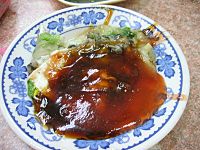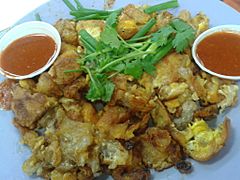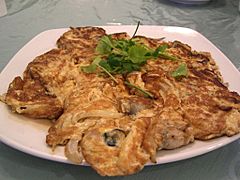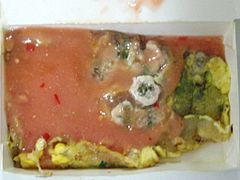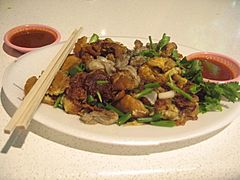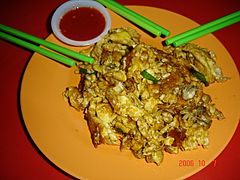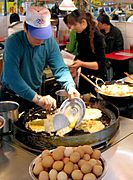Oyster omelette facts for kids
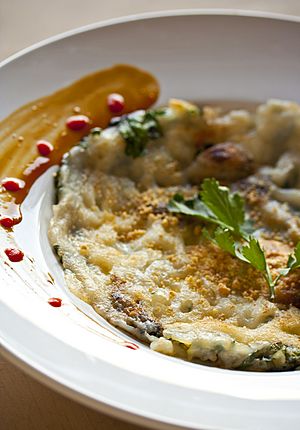 |
|
| Course | Breakfast, lunch, and dinner |
|---|---|
| Place of origin | Banlam and Teoswa, China |
| Created by | Banlamese people (Hokkien and Teochew people) |
The oyster omelette, as known as o-a-tsian (Chinese: 蚵仔煎; Pe̍h-ōe-jī: ô-á-chian), o-chien (Chinese: 蚵煎; Pe̍h-ōe-jī: ô-chian) or orh luak (simplified Chinese: 蚝烙; traditional Chinese: 蠔烙; Peng'im: o5 luah4) is a dish of Banlamese (both Hokkien and Teochew) origin that is renowned for its savory flavor in its native Minnan region and Chaoshan, along with Taiwan and many parts of Southeast Asia such as the Philippines, Thailand, Malaysia and Singapore due to the influence of the Banlamese diaspora. Variations of the dish exist in some southern regions of China.
Summary
The oyster omelette is a Taiwanese "night market favorite", and has constantly been ranked by many foreigners as the top dish from Taiwan. Its generous proportions and affordable price demonstrates the trait of night market cuisines. In the Philippines, English language menus often call the dish "oyster cake".
Ingredients
The dish consists of an omelette with a filling primarily composed of small oysters. Starch (typically sweet potato starch) is mixed into the egg batter, giving the resulting egg wrap a thicker consistency. Pork lard is often used to fry the resulting omelet. Depending on regional variations, a savory sauce may then be poured on top of the omelette for added taste.
Spicy or chili sauce mixed with lime juice is often added to provide an intense kick. Shrimp can sometimes be substituted in place of oysters; in this case, it is called shrimp omelette (蝦仁煎).
Names
In different Chinese languages, the "oyster omelette" is known by various names in different Chinese geographical regions.
| Chinese name | Pronunciations in different spoken variations | Geographical areas that use such a name |
|---|---|---|
| 蠔烙 | In Teochew: o5 luah4 In Mandarin: háo lào |
In Chaoshan region and overseas communities connected to the region. |
| 蚵仔煎 | In Hokkien and Taiwanese Hokkien: ô-á-chian In Mandarin: ézǎi jiān |
Southern Fujian, Taiwan, and Philippines |
| 蚵煎 | In Hokkien: ô-chian | Southern Fujian, Malaysia, Singapore, and Philippines |
| 牡蠣煎 | In Mandarin: mǔlì jiān | Most areas of mainland China |
| 海蠣煎 | In Mandarin: hǎilì jiān | Southern Fujian |
| 蠔煎 | In Cantonese: hòuh jīn In Mandarin: háo jiān |
Chaoshan, Singapore, Malaysia and Indonesia |
| 煎蠔餠 | In Cantonese: jīn hòuh béng In Hakka: jien hao biang In Mandarin: jiān háo bǐng |
Hong Kong, Macau and neighboring Liangguang |
| 蠔仔餠 | In Cantonese: hòuh jái béng In Hakka: hao zhai biang |
Hong Kong, Macau and the Pearl River Delta |
| 蠔仔煎 | In Cantonese: hòuh jái jīn In Hakka: hao zhai chien |
Hong Kong, Macau and the Pearl River Delta |
Thailand
In Thailand known as Hoi Thod (Thai: หอยทอด), it was adapted to mussel omelettes (Hoi Mleang Phu Thod, Thai: หอยแมลงภู่ทอด), though the original oyster version (Hoi Nang Rom Thod, Thai: หอยนางรมทอด) also common but higher price. In Bangkok, notable areas for oyster omelettes include Talat Wang Lang near Siriraj Hospital; Wang Lang (Siriraj) Pier in Bangkok Noi where there are two restaurants; Yaowarat neighborhood, where there is one Michelin-Bib Gourmand restaurant with Charoen Krung neighborhood in Bang Rak, among others. In 2017, the World Street Food Congress announced that oyster omelette is one of the three most notable street food among the street foods of Thailand.
Gallery
See also
 In Spanish: Tortilla de ostra para niños
In Spanish: Tortilla de ostra para niños


